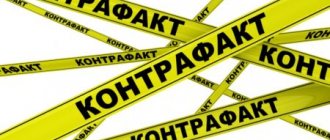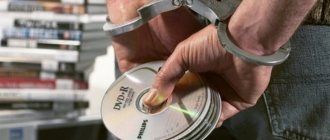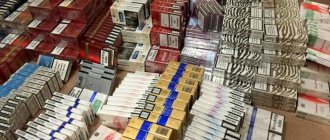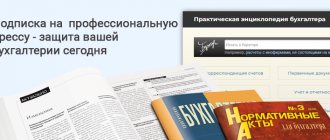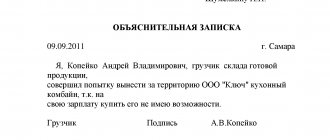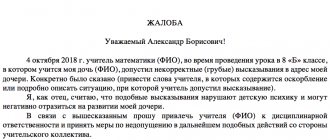What are counterfeit products? What are the different types of counterfeit? What is the liability for the distribution of counterfeit products in Russia? How is the fight against counterfeit products in the international arena? What has the ICC done to combat counterfeiting?
Counterfeit products mean any product that is manufactured in violation of the intellectual, copyright and other property rights of third parties. For example, a company producing similar products uses the logo of a famous brand. The goals are clear, because such products are much easier to sell than products from a little-known company.
Counterfeit and falsified products: what's the difference?
The concept of “counterfeit products” indicates an infringement of copyright and other related rights, for example, intellectual rights.
The creation of a counterfeit product increases the value of the original, since in appearance and in its technical properties the counterfeit product is in many ways inferior to the original product. Unlike counterfeit, counterfeit can be of very good quality. Counterfeit items are very low quality goods that are passed off as original. However, in any case, this deprives owners of income from the brand, since the originals are replaced by fakes. Sometimes frequent mention of a brand name sharply reduces not only the overall revenue of the brand, but is also detrimental to quality and image. Moreover, most companies in the world suffer from this. All branded products that are in high demand are counterfeited in export markets.
What is a counterfeit product?
The concept of counterfeit goods is often a subject of confusion and misuse. Thus, counterfeit products often mean any illegal product, smuggling, or simply not meeting established requirements and state standards or not having permits. This opinion is completely wrong. Current legislation and global standards classify only certain types of products as counterfeit.
Thus, the general definition of counterfeit in global law implies products that violate the existing intellectual rights of other persons. However, Russian legislative acts also provide an incorrect interpretation of this term. For example, Federal Law No. 323 of November 21, 2011 classifies as counterfeit medical products any such products, the circulation of which constitutes a violation of current civil legislation. Further in the article, counterfeit products will only mean products that violate anyone’s copyright.
Based on this logic, they are not counterfeit:
- Smuggled products, but produced legally by the direct manufacturer;
- Products from a real manufacturer that do not have the necessary excise taxes and circulation permits;
- A product that is of low quality and does not meet standards, but also produced by a legal manufacturer.
Important
Counterfeit and counterfeit are similar terms, but have a number of differences. Thus, a sign of counterfeit is counterfeit products that imitate any brand, trademark, logo, and are of low quality. At the same time, counterfeit products may be of adequate quality and even superior to the original. Thus, counterfeit is a particular type of counterfeit product.
What are the different types of counterfeit products?
1) Using a company name or label that is very similar to a well-known brand.
In counterfeit products, the manufacturer changes 1 or 2 letters, and the label has a different meaning or is read differently. For example, the name adidas can be written as addiddass, adadass, etc. 2) Using someone else’s name without making changes to it. Some risky manufacturers copy not only the authentic logo, but also the external properties of the product, such as color, shape, quality, etc. The fact of copyright infringement is obvious, so such products are much less common. It is easier to hold the distributor of such products accountable, since it is easy to prove the fact of violation of rights.
3) "Piracy". This is a form of violation of copyright and related rights in which artistic, musical, literary works are copied without the permission of the copyright holder. Often violators go for free counterfeit goods. This is when musical works and original video products are distributed on the Internet.
- International piracy. How business and the ICC are fighting it
4) Use of developments, inventions, software registered to other persons. The fact of violation is also obvious.
Civil lawsuit in court
With the help of a civil lawsuit, the copyright holder can achieve not only a ban on the use of his brand, but also demand compensation for damages or demand satisfaction of his other claims. Such requirements include a ban on the import and sale of counterfeit goods in the country, as well as its seizure and destruction at the expense of the offender.
The framework of the Civil Code allows us to expect compensation not only for property losses, but also for reputational damage. Most often, copyright holders seek compensation for the use of their mark of up to 5 million rubles, but it is awarded in such an amount extremely rarely; more often, the courts reduce it, at best, to a million rubles.
You can try to achieve compensation based on double the cost of manufactured goods that have someone else’s brand on them, but this only makes sense in very large volumes of counterfeit products. Compensation may also be requested based on twice the cost of the license to legally use the brand.
To ensure that the court does not ultimately reduce the amount of compensation, or at least does not do so too much, it is recommended to justify its amount together with experienced lawyers. You can refer to the long period of use of someone else's intellectual property and, if possible, indicate that this is not the first time the violator has violated your rights.
Often, copyright holders seek compensation for the illegal use of their brand, since they do not have to prove that a certain amount of damage was incurred. The very fact that someone else's rights were violated is enough.
Responsibility for counterfeit products in Russia. What problems exist?
The following documents combat counterfeit products in Russia: 1. Criminal Code of the Russian Federation:
- Art. 146 Violation of copyright and related rights. — St. 180 Illegal use of a trademark. — St. 147 Infringement of inventive and patent rights.
2. Administrative Code of the Russian Federation:
— St. 28.7 Administrative Investigation. — St. 14.10 Illegal use of a trademark. — St. 7.12 Violation of copyright and related rights, inventive and patent rights - Article 4.5 Limitation period for bringing to administrative liability. — St. 32.4 Execution of a decision on paid seizure or confiscation of a thing that was an instrument of commission or the subject of an administrative offense.
In order to hold an individual or legal entity liable under one of the above articles, strong evidence and documentary evidence of a violation of property rights are required. However, it is not always possible to identify evidence of violations - documents, audio and video files, which is a problem that is more relevant today than ever. On the territory of the Russian Federation, counterfeit products are not only produced in large volumes, but are also imported from abroad, especially from China. Moreover, all such products have all the necessary accompanying documents.
Federal laws and violations related to business activities, which are established by the relevant tax departments and services, help combat counterfeit products produced in Russia. If counterfeit goods have already passed sanitary, customs, or any other control, then it is even more difficult to fight such products and companies that have violated rights. If such a counterfeit product has no defects and has all the permitting documents, then it is difficult to legally prohibit its sale. This requires leverage and other measures of influence at the international level.
All that can be done is to impose a fine, but most often its size does not cover even 10% of losses from the very fact of the appearance of counterfeit goods and services on the market. Legislators are constantly looking for mechanisms to tighten measures for violators, but what they should be has not yet been decided.
How can the copyright holder stop the sale of counterfeit goods?
Increasing brand popularity inevitably leads to an increase in the number of counterfeit products. The Russian market is filled with fakes of varying quality. For example, counterfeit shoe products are divided into several categories depending on the quality of the counterfeit: starting with low-quality models of the cheap segment, which are associated with the brand only because of the applied trademark of the copyright holder, and ending with counterfeits of specific models and lines of shoes, which can be distinguished from the original only with close study.
The sale of counterfeits is large-scale and occurs both via the Internet and in wholesale and retail stores, including large shopping centers. The identification and suppression of the activities of such unscrupulous entrepreneurs is not always carried out to the fullest extent, and therefore the copyright holder has to independently organize the protection of the trademark. In a competitive environment between brands, the organization of such practices can be positioned as a competitive advantage when attracting counterparties.
The choice of method of protecting the exclusive right to a trademark depends on the specific situation, but the most universal and effective is to contact law enforcement agencies with a statement to prosecute entrepreneurs selling counterfeit goods in accordance with Art. 144–145 Code of Criminal Procedure of the Russian Federation. Even if the actions of these persons do not constitute a crime under Art. 180 of the Criminal Code of the Russian Federation, the person conducting the inspection is obliged to consider the issue of bringing to justice for committing an administrative offense under Part 2 of Art. 14.10 Code of Administrative Offenses of the Russian Federation. In addition, the ability of law enforcement agencies to quickly suppress the illegal trade in counterfeits and remove them from trade significantly distinguishes this method of trademark protection from among others.
The following recommendations will help you get an idea of how the trademark owner organizes anti-counterfeiting practices.
1. It is necessary to remember the goals of combating counterfeit products
Counterfeit products, even of the highest quality, are incomparable to the original. Most sellers mislead consumers by positioning counterfeits as genuine goods. As a result, the consumer does not receive the declared quality of the product, which significantly affects the brand’s reputation and leads to the user forming a negative opinion about the company that owns the exclusive rights to the trademark. It is the withdrawal of such goods from civilian circulation and its subsequent destruction that are the main goals of organizing anti-counterfeiting practices in the company.
Punishing an entrepreneur involved in the sale of counterfeit products and preventing him and other persons from committing new similar offenses are related goals. However, in some cases there is no need to insist on holding a person accountable. It happens that an entrepreneur is ready to voluntarily destroy, under a video report, the entire batch of counterfeit goods that he has in stock. Such situations are rare and are associated with information leakage either from law enforcement agencies or from regional clients of the product manufacturer who have information about the inspection being carried out. Under such circumstances, the copyright holder should consider possible options for resolving the issue of the entrepreneur’s independent destruction of counterfeit goods, subject to his refusal to further illegal use of the trademark.
2. Third-party consultant or in-house legal department?
The initial task of organizing anti-counterfeiting practice in a company is to resolve the issue of who will legally formalize the results of inspections of stores for illegal use of a trademark. The company can hire a third-party consultant or handle it with its own legal department.
Each option has its pros and cons. For example, a lawyer who has exclusive rights to collect evidence may be hired as a third-party consultant (in particular, the lawyer has the right to interview a person with his consent to record additional information in the protocol). In addition, the decision to engage a third-party consultant allows for a wide choice of performers on the market with the assignment of any amount of authority, ranging from preparing draft applications to law enforcement agencies and ending with the full implementation of anti-counterfeiting practices in the company.
Having your own legal department compared to hiring a consultant is beneficial from the point of view of cost optimization. However, it is possible that the attention of the company’s lawyers, who will have to deal with this area of work and the current legal support for the organization’s activities, is scattered, which can lead to a deterioration in the quality of work in both areas. The way out of this situation is to distribute projects among employees, train direct performers in methods of combating counterfeiting, or increase the staff of the legal department.
Thus, the company’s management selects the contractor and decides on the scope of his powers, taking into account the organization’s capabilities and the scale of the anti-counterfeiting project.
3. Establishing an optimal mechanism for identifying counterfeit goods
Information about the sale of counterfeit products can come to an organization from several sources:
- from the company's counterparties. Often they inform regional managers or directly the management of the organization about the trade in counterfeit goods at a nearby outlet. As a rule, in such stores, counterfeit products are cheaper than original products, which significantly affects the sales of the company’s client;
- from consumers of counterfeit products who have submitted claims to the manufacturer of the goods regarding the quality of products purchased from entrepreneurs selling counterfeits;
- on the basis of monitoring of the Internet organized by the company, in particular social networks. In some cases, sellers do not deny selling “copies of excellent quality,” which makes it easier to bring them to administrative and criminal liability.
Information about unscrupulous entrepreneurs should be entered into a specially created register to optimize the work of the contractor in combating the sale of counterfeit goods in the region. After structuring the data, you can begin to check it and begin collecting documents to send an application to law enforcement agencies.
4. Careful collection of inspection materials for submission to law enforcement agencies is the basis for success
Organizing the verification of information provided or found about the trade in counterfeit goods solves important problems. First, you need to make sure that a counterfeit store exists. Secondly, the purchase of a counterfeit product by an inspector will allow the submission of additional documents and the counterfeit product itself, which will significantly increase the weight of the application submitted to law enforcement agencies.
The application must contain a full description of the inspection organized by the copyright holder: the source of information about the trade in counterfeit goods (monitoring of the Internet, complaints from contractors, messages from regional managers, complaints from consumers about the quality of products that turned out to be counterfeit, etc.), addresses and names of stores (if available, the name of the owner). Often, the sale of counterfeits is carried out by persons who are not registered as individual entrepreneurs, which must also be reflected in the statement of crime/offense in order to make a decision on the fact of illegal business.
In addition, if the organization has a network of regional sales managers, it is worth interviewing them (if a lawyer collects evidence) and attaching the survey results to the application to law enforcement agencies. The following questions must be clarified from the manager: his position, responsibilities, whether there have been any complaints from the company’s clients in the region he serves about the trade in counterfeit goods. If there were, then it is necessary to find out at what addresses the retail sale of counterfeits is carried out, the name of the store and organization, whether the manager visited these stores in order to confirm the arguments of customer complaints.
If the purchase was made by a manager, during his survey it is necessary to clarify information about the scheme for selling counterfeit goods in each store: what the store is like (a store with a sign, a closed showroom, a warehouse), what is the range of counterfeit products, how the goods are purchased (through store website, social networks, directly in the store), the cost of the purchased goods, whether a cash receipt/sales receipt was issued, if not, then to what bank card number the transfer for the goods was made, whether a written guarantee about the quality of the goods was issued when purchasing counterfeit goods.
The manager can also talk about the signs by which he determines the purchased product as counterfeit: the absence of an entrepreneur selling counterfeits in the customer base of the organization that imported the product, a discrepancy between the article number of the counterfeit product, packaging, material, release form, etc. criteria of the original product. You can also interview the counterparty who sent the copyright holder information about the sale of counterfeit goods.
An approximate list of documents required to be included in an application to law enforcement agencies for the sale of counterfeit goods includes:
- power of attorney from the organization to represent interests in law enforcement agencies;
- extracts from the Unified State Register of Legal Entities/Unified State Register of Individual Entrepreneurs for the principal and inspected entrepreneurs;
- statutory documents of the principal;
- trademark certificates with attachments;
- protocol of interviewing a person (the principal's employee or the principal's counterparty) with his consent;
- cash receipts/sales receipts or other documents confirming the sale of counterfeit goods by the entrepreneur;
- if the goods are imported - a copy of the information letter of the Federal Customs Service of Russia about the trademarks of the copyright holder;
- photographs of the sales area of the store where the counterfeit products were purchased;
- screenshots of the websites of the stores being checked, their pages on social networks and other documents.
Collecting the most complete package of documents attached to the application will eliminate red tape regarding verification materials based on a request for additional information.
5. Decision control
Without proper control on the part of the contractor over the timing and results of the verification of the application, high-quality organization of practice to combat counterfeit products is impossible. It is necessary to seek a response from law enforcement agencies in each case of identified sales of counterfeits. If there is no response from the subject of the audit regarding the statement of crime/offense, requests should be sent to law enforcement agencies to obtain information about the measures they have taken to suppress the sale of counterfeit products. If an improper check was carried out or insufficient measures were taken, it is necessary to send a complaint to the prosecutor's office or court in order to cancel the illegal decision, as well as the inaction of officials on the application.
Let us note that after an inspection has been carried out in relation to a particular entrepreneur and he has been brought to justice, further control over his activities by the copyright holder is necessary. If an unscrupulous entrepreneur was initially brought to administrative responsibility for selling counterfeit goods, then later, when the counterfeit is sold again, he can be immediately brought to criminal liability without taking into account the amount of harm caused. In this regard, the company should establish monitoring of unscrupulous entrepreneurs in order to instill in such individuals the conviction that the copyright holder is intransigent with the sale of counterfeit products and the inevitability of punishment.
Fighting counterfeit products internationally
At the end of 2010, work was completed on a multilateral agreement called the Anti-Counterfeiting Agreement (“ASTA”).
This is the first international agreement aimed at combating the emergence of counterfeit products. The main provisions of the agreement are distinguished by a high level of unification and the development of a strategy for the full coordination of the process. In addition, experts have developed to combat global networks operating today and using new ones.
The documents received such support from business representatives, for example the ICC, and a counter initiative was put forward - BASCAP. The ASTA Agreement began to operate in 2011.
The provisions of the document provide:
— High standards and expansion of business cooperation to combat counterfeiting; — Active involvement of legal norms and laws; — Application of effective criminal sanctions; — Expanding business cooperation between law enforcement agencies at the global level; — Expanding business and other partnerships between government organizations, small and large businesses.
ICC's involvement in the fight against counterfeit products
The ICC is active in the fight against counterfeit products.
This is done in various ways, including through the planned Intellectual Property Commission. This makes it possible to create a favorable environment for industrial and other companies of all forms of ownership that use IP objects on a global scale, namely: 1) BASCAP
is a business initiative created to combat counterfeit and pirated products. It was adopted by the International Chamber of Commerce specifically to mobilize business forces across all national borders. The goal is to fight against counterfeit products and piracy. With the goal of universally pooling the resources and experience of business, government organizations, the public and the media. BASCAP official website: www.bascap.com.
- International initiative BASCAP: goals, objectives, results of meetings.
2) ICC Roadmap on Intellectual Property for Business and Policy.
This ICC publication provides business and government officials with regularly updated information on the most important developments in international copyright and intellectual property protection. The Roadmap pays particular attention to the spread of digital, communication technologies, the Internet and the impact of such business evolution on IP rights. It is revised every two years and is available in 5 official languages, including English, Chinese, Spanish, Arabic and Portuguese.
You can find the Road Map at www.iccbooks.com.
